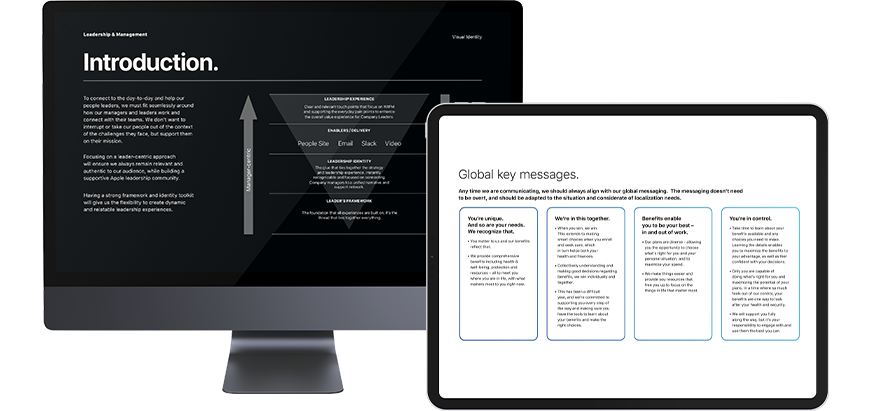Internal communication is more important than ever in today’s fast-paced business world, where collaboration, innovation and agility are essential for success. However, with so many priorities to juggle, it can be challenging for internal communicators to know where to focus their efforts.
The good news is that with challenge comes opportunity, and, by prioritizing the right things, internal communicators can have a significant impact on their organization’s success. As experts in the field, we’ve worked with numerous clients over the past decade, and we’ve learned a thing or two about what really matters in internal communication.
We support hundreds of clients with their internal communication every year and we’ve learnt a few best practices along the way. In this article, we’ve outlined nine hallmarks of great internal communication.
1 Have a defined purpose and strategy
As an internal communicator, your organization’s internal communication function should have a clearly articulated value proposition that helps leaders make informed decisions aligned with the organization’s long-term objectives.
Think about how your role supports the business, what it’s there for and why it’s an essential part of the strategic picture. Employees who understand the organization’s purpose and strategy – thanks to effective internal communications – are more engaged and motivated because they can see how their work contributes to the bigger picture.
Have a look at this article to find out how to create a successful internal communication strategy.
2 Construct a clear narrative
Crafting a compelling strategic narrative is essential when it comes to driving a better understanding of your organization’s purpose.
Constructing a clear narrative and a watertight content strategy is essential for building a connection with stakeholders, clarifying the organization’s purpose and direction, enhancing brand identity and reputation, and facilitating effective communication. It will also help you make best use of your budget and ensure that everything you create is aligned with it.
Find out how our internal communication consultants can help you connect your people to your purpose, strategy and values.
3 Manage your channels effectively
As the amount of new ‘must-have’ digital platforms increases, it’s becoming increasingly difficult for employees to know where to go for the basic information they really need. It’s not enough to simply develop a basic channel framework and hope that everything miraculously falls into place – give everything a clear purpose, review your channels regularly, and be confident in the decisions you make about how you use the communication tools at your disposal.
Need help with your internal communication strategy?
Get in touch
4 Build a robust communication capability
The core purpose of any internal communication team is to support its leaders in becoming excellent communicators, and also to equip internal influencers to amplify its messaging. Today’s world-class internal communicators set specific goals and objectives that align with the overall business strategy, identify gaps and areas for improvement, then develop a plan to address these.
Develop a communication strategy based on your goals that outlines key messages, target audiences, channels and metrics for success. Ensure that your leaders and employees have the skills and resources they need to communicate effectively. Provide training and develop opportunities to enhance communication skills.
A combination of strategic planning, investment in resources and training, and a culture that prioritizes communication excellence will build robust communication capability.
5 Promote open dialogue and collaboration
Internal communication needs to be the voice of the employee at the top table. Your ability to keep your finger on the pulse and see things through a human lens is what will increase your influence with the leadership team.
Key to making this happen is promoting open dialogue and collaboration in a safe space. Foster a culture of transparency, encourage collaboration, provide training and resources, and lead by example. If you do this, you can create a collaborative and innovative culture that supports your organization’s success.
6 Focus on insight, measurement, and evaluation
Measuring internal communication is important for demonstrating the valuable contribution that your internal communications make to your organization’s business objectives. Set clear objectives for your communication initiatives, and make sure these are in line with your business objectives and key performance indicators. Use data and analytics to measure the impact of your communication on employee engagement and productivity.
Establish benchmarks based on historical data and industry standards to track progress, identify areas for improvement, and communicate results to key stakeholders. This will continually improve the impact of your communication.
Being able to demonstrate your value is key to building your influence where it counts.
7 Influence change and transformation
Work with those in the know to get close to the transformation agenda. Internal communicators can influence business transformation by effectively communicating goals, progress and benefits to employees. This creates a sense of ownership and urgency, encouraging two-way communication to gather feedback and ideas from employees.
You can also facilitate cross-functional collaboration and knowledge sharing to support the transformation and change process.
In doing so, internal communicators can help to build the culture of innovation, agility and continuous improvement essential for successful business transformation.
8 Champion culture and employee experience
Your greatest opportunity as communicators is to not only shape the culture of your organization, but also how it comes to life through your Employee Experience (EX). Having a strong purpose can inspire and motivate employees towards a common goal and create a sense of belonging.
EX is about breaking down silos to make people feel different about work. It aims to create a positive work environment in which a culture of respect, inclusivity and open communications can thrive.
Leaders play a crucial role in shaping organizational culture and employee experience. By modelling desired behaviors, providing clear direction, and recognizing and rewarding positive contribution, leaders can inspire and motivate employees to do their best work.
9 Become a trusted adviser
Becoming a trusted advisor requires a combination of skills, experience and mindset. Develop strong relationships with key stakeholders. Listen to their needs and concerns, and work towards common goals.
Making your presence felt in the right way is critical to gaining a deeper understanding of the business objectives and challenges, as well as anticipating communication needs and opportunities.
Measuring and communicating the impact of your communication and the return on the investment also helps to build trust.
In summary, becoming a trusted communications advisor requires you to build relationships, understand the business, communicate effectively, demonstrate value and be a proactive team player.
See how our internal communications consultants can help you today, and contact us to discuss the tangible differences we could make to your organization.

